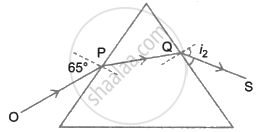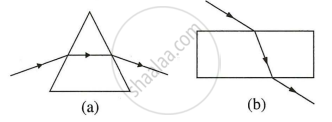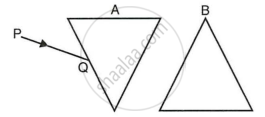Advertisements
Advertisements
Question
The diagram below shows the ray OP travelling through an equilateral prism of a certain material.
- Calculate the value of i2, if the angle of deviation is 43°.
- What is the ray QS called?

Solution
a. Using Prism formula,
∠A + ∠δ = ∠i1 + ∠i2
60° + 43° = 65° + Li2
∴ m∠i2 = 38°
b. Ray QS is called the emergent ray.
APPEARS IN
RELATED QUESTIONS
The deviation produced by a prism is independent of the angle of incidence and is same for all the colours of light.
Diagrams (a) and (b) in figure below show the refraction of a ray of light of single colour through a prism and a parallel sided glass slab respectively.

- In each diagram, label the incident, refracted, emergent rays and the angle of deviation.
- In what way the direction of emergent ray in the two cases differ with respect to the incident ray? Explain your answer.
A ray of light incident at an angle of incidence i1 passes through an equilateral glass prism such that the refracted ray inside the prism is parallel to its base and emerges at an angle of emergence i2.
- How is the angle of emergence ‘i2’ related to the angle of incidence ‘i1’.
- What can you say about the angle of deviation in such a situation?
How does the angle of deviation depend on the refracting angle of the prism?
A ray of light is normally incident on one face of an equilateral glass prism. Answer the following:
What is the angle of refraction from the first face of the prism?
In following figure shows two identical prisms A and B placed with their faces parallel to each other. A ray of light of single colour PQ is incident at the face of the prism A. Complete the diagram to show the path of the ray till it emerges out of the prism B.

[Hint: The emergent ray out of the prism B will be parallel to the incident ray PQ]
A ray of light suffers refraction through an equilateral prism. The deviation produced by the prism does not depend on the ______.
Explain the phenomenon of dispersion of white light through a glass prism, using suitable ray diagram.
The angle between two plane rectangular refracting surfaces of a prism is called as
Name the colour of white light which is deviated the least on passing through a prism.
